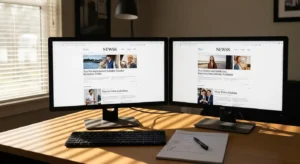How the Death Rumor Began
The speculation began over Labor Day weekend when Trump, then 79, was noticeably absent from public appearances. Online users pointed to a photo showing a bruise on his right hand, which quickly fueled speculation that his health was failing. Within hours, posts claiming he had passed away began circulating with alarming speed. Some included fabricated “breaking news” screenshots that mimicked the style of major TV networks.
The absence, combined with the out-of-context photo, created a fertile environment for rumors. Hashtags such as #RIPTrump trended on X (formerly Twitter), and several obscure blogs rushed out “obituaries” without citing credible sources.
Trump’s Response on Live TV
On September 2, 2025, Trump appeared on live television and spoke directly about the rumors. With his signature bluntness, he called the stories “pretty serious stuff” and dismissed them as another example of social media gone wild. He joked about being alive and noted that the rumors were frustrating not only to him but also to his family and supporters.
His appearance instantly silenced the chatter, but the episode raised bigger questions about why such rumors spread so easily and what impact they have on public discourse.
Why the Rumors Spread So Fast
Several factors contributed to the viral spread of the Trump death hoax:
- Public absence: Long gaps in visibility make speculation more likely, especially for high-profile figures.
- Health speculation: At Trump’s age, even minor details such as bruises are often misinterpreted as signs of serious illness.
- Clickbait economy: Websites profit from sensational headlines and ad revenue, even if the claims are false.
- AI-generated fakes: With modern tools, anyone can create convincing but fake “news” images in minutes.
These ingredients combined into a perfect storm that allowed the rumor to spread faster than fact-checks or official responses could catch up.
The Role of Social Media in Amplifying Death Hoaxes
 Social media plays a central role in how death hoaxes gain traction. Algorithms reward engagement, which means shocking content—like the supposed death of a former U.S. president—spreads widely before corrections appear. In Trump’s case, quote-posting, retweets, and algorithmic boosts ensured that false claims reached millions of people within hours.
Social media plays a central role in how death hoaxes gain traction. Algorithms reward engagement, which means shocking content—like the supposed death of a former U.S. president—spreads widely before corrections appear. In Trump’s case, quote-posting, retweets, and algorithmic boosts ensured that false claims reached millions of people within hours.
By the time Trump spoke on TV, millions had already seen the hashtag #RIPTrump. For many, the correction didn’t travel as far as the original rumor. This pattern repeats itself with nearly every celebrity hoax, from actors to athletes to politicians.
What Officials Said About Trump’s Health
While the rumors were unfounded, the photo of the bruise did prompt questions. The White House physician explained that the mark was the result of common bruising from frequent handshakes and regular aspirin use, nothing unusual for someone of Trump’s age. Family members also criticized the rumor mill for causing unnecessary panic and distress.
This shows how even a minor, innocent detail can be misinterpreted and magnified in the online rumor cycle.
The Harm of Death Hoaxes
Death hoaxes may appear trivial, but they have real consequences:
- Emotional harm: Family, friends, and supporters may experience stress and grief when they see false obituaries.
- Public confusion: Once a rumor trends, many people are left unsure about the truth, even after it is debunked.
- Media trust erosion: Frequent hoaxes reduce trust in both traditional and digital news outlets, making it harder for real stories to gain traction.
When the subject is a figure as polarizing and globally recognized as Donald Trump, the potential damage is multiplied.
How to Verify Before Sharing Death News
 To avoid spreading misinformation, readers can use these fact-checking strategies:
To avoid spreading misinformation, readers can use these fact-checking strategies:
- Look for reports from multiple credible outlets such as Reuters, AP, or BBC.
- Check for an official statement from family members, representatives, or verified accounts.
- Be wary of screenshots without links, especially those that mimic breaking news graphics.
- Search the person’s official website or social media for confirmation.
For more guidance, see our resources: The Importance of Verified Reporting in Death Announcements and A Guide to Submitting an Obituary on NewDeaths.com.
Frequently Asked Questions
Did Donald Trump die in September 2025?
No. He appeared on live TV and personally addressed the rumors, confirming he is alive.
What caused the rumors?
A short absence from public appearances, paired with a photo of a bruise on his hand, led to speculation that spiraled out of control.
How did Trump respond?
He dismissed the rumors as “pretty serious stuff” and criticized the speed at which false stories spread online.
Conclusion
The Donald Trump death hoax of September 2025 shows just how quickly misinformation can spread in the digital age. What began as speculation turned into a trending rumor seen by millions, despite lacking any credible evidence. Trump’s live TV response put the rumors to rest, but the episode highlights the need for responsible sharing and careful verification. Before you click “share,” take a moment to confirm the truth. Accuracy protects not only public trust but also the families and legacies of those caught in false reports.
